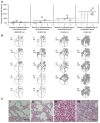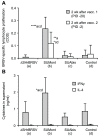Vaccine safety and efficacy evaluation of a recombinant bovine respiratory syncytial virus (BRSV) with deletion of the SH gene and subunit vaccines based on recombinant human RSV proteins: N-nanorings, P and M2-1, in calves with maternal antibodies
- PMID: 24945377
- PMCID: PMC4063758
- DOI: 10.1371/journal.pone.0100392
Vaccine safety and efficacy evaluation of a recombinant bovine respiratory syncytial virus (BRSV) with deletion of the SH gene and subunit vaccines based on recombinant human RSV proteins: N-nanorings, P and M2-1, in calves with maternal antibodies
Abstract
The development of safe and effective vaccines against both bovine and human respiratory syncytial viruses (BRSV, HRSV) to be used in the presence of RSV-specific maternally-derived antibodies (MDA) remains a high priority in human and veterinary medicine. Herein, we present safety and efficacy results from a virulent BRSV challenge of calves with MDA, which were immunized with one of three vaccine candidates that allow serological differentiation of infected from vaccinated animals (DIVA): an SH gene-deleted recombinant BRSV (ΔSHrBRSV), and two subunit (SU) formulations based on HRSV-P, -M2-1, and -N recombinant proteins displaying BRSV-F and -G epitopes, adjuvanted by either oil emulsion (Montanide ISA71VG, SUMont) or immunostimulating complex matrices (AbISCO-300, SUAbis). Whereas all control animals developed severe respiratory disease and shed high levels of virus following BRSV challenge, ΔSHrBRSV-immunized calves demonstrated almost complete clinical and virological protection five weeks after a single intranasal vaccination. Although mucosal vaccination with ΔSHrBRSV failed to induce a detectable immunological response, there was a rapid and strong anamnestic mucosal BRSV-specific IgA, virus neutralizing antibody and local T cell response following challenge with virulent BRSV. Calves immunized twice intramuscularly, three weeks apart with SUMont were also well protected two weeks after boost. The protection was not as pronounced as that in ΔSHrBRSV-immunized animals, but superior to those immunized twice subcutaneously three weeks apart with SUAbis. Antibody responses induced by the subunit vaccines were non-neutralizing and not directed against BRSV F or G proteins. When formulated as SUMont but not as SUAbis, the HRSV N, P and M2-1 proteins induced strong systemic cross-protective cell-mediated immune responses detectable already after priming. ΔSHrBRSV and SUMont are two promising DIVA-compatible vaccines, apparently inducing protection by different immune responses that were influenced by vaccine-composition, immunization route and regimen.
Conflict of interest statement
Figures








Similar articles
-
A new subunit vaccine based on nucleoprotein nanoparticles confers partial clinical and virological protection in calves against bovine respiratory syncytial virus.Vaccine. 2010 May 7;28(21):3722-34. doi: 10.1016/j.vaccine.2010.03.008. Epub 2010 Mar 20. Vaccine. 2010. PMID: 20307593 Free PMC article.
-
Characterization of an experimental vaccine for bovine respiratory syncytial virus.Clin Vaccine Immunol. 2014 Jul;21(7):997-1004. doi: 10.1128/CVI.00162-14. Epub 2014 May 14. Clin Vaccine Immunol. 2014. PMID: 24828093 Free PMC article.
-
Vaccination with recombinant modified vaccinia virus Ankara expressing bovine respiratory syncytial virus (bRSV) proteins protects calves against RSV challenge.Vaccine. 2007 Jun 15;25(25):4818-27. doi: 10.1016/j.vaccine.2007.04.002. Epub 2007 Apr 20. Vaccine. 2007. PMID: 17499893
-
Immunology of bovine respiratory syncytial virus in calves.Mol Immunol. 2015 Jul;66(1):48-56. doi: 10.1016/j.molimm.2014.12.004. Epub 2014 Dec 29. Mol Immunol. 2015. PMID: 25553595 Review.
-
[Immunobiology of bovine respiratory syncytial virus infections].Tijdschr Diergeneeskd. 1998 Nov 15;123(22):658-62. Tijdschr Diergeneeskd. 1998. PMID: 9836385 Review. Dutch.
Cited by
-
Partial Attenuation of Respiratory Syncytial Virus with a Deletion of a Small Hydrophobic Gene Is Associated with Elevated Interleukin-1β Responses.J Virol. 2015 Sep;89(17):8974-81. doi: 10.1128/JVI.01070-15. Epub 2015 Jun 17. J Virol. 2015. PMID: 26085154 Free PMC article.
-
First demonstration of the circulation of a pneumovirus in French pigs by detection of anti-swine orthopneumovirus nucleoprotein antibodies.Vet Res. 2018 Dec 5;49(1):118. doi: 10.1186/s13567-018-0615-x. Vet Res. 2018. PMID: 30518406 Free PMC article.
-
A Review of UK-Registered and Candidate Vaccines for Bovine Respiratory Disease.Vaccines (Basel). 2021 Nov 27;9(12):1403. doi: 10.3390/vaccines9121403. Vaccines (Basel). 2021. PMID: 34960149 Free PMC article. Review.
-
New Insights Contributing to the Development of Effective Vaccines and Therapies to Reduce the Pathology Caused by hRSV.Int J Mol Sci. 2017 Aug 11;18(8):1753. doi: 10.3390/ijms18081753. Int J Mol Sci. 2017. PMID: 28800119 Free PMC article. Review.
-
Single-Shot Vaccines against Bovine Respiratory Syncytial Virus (BRSV): Comparative Evaluation of Long-Term Protection after Immunization in the Presence of BRSV-Specific Maternal Antibodies.Vaccines (Basel). 2021 Mar 9;9(3):236. doi: 10.3390/vaccines9030236. Vaccines (Basel). 2021. PMID: 33803302 Free PMC article.
References
-
- Seiffert SN, Hilty M, Perreten V, Endimiani A (2013) Extended-spectrum cephalosporin-resistant gram-negative organisms in livestock: An emerging problem for human health? Drug Resist Updat. doi:10.1016/j.drup.2012.12.001. - PubMed
-
- Kimman TG, Zimmer GM, Westenbrink F, Mars J, van Leeuwen E (1988) Epidemiological study of bovine respiratory syncytial virus infections in calves: influence of maternal antibodies on the outcome of disease. Vet Rec 123: 104–109. - PubMed
-
- Kimman TG, Westenbrink F, Straver PJ (1989) Priming for local and systemic antibody memory responses to bovine respiratory syncytial virus: effect of amount of virus, virus replication, route of administration and maternal antibodies. Vet Immunol Immunopathol 22: 145–160. - PubMed
Publication types
MeSH terms
Substances
Grants and funding
LinkOut - more resources
Full Text Sources
Other Literature Sources
Miscellaneous

